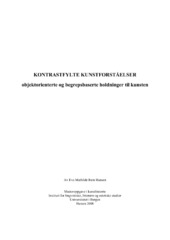Kontrastfylte kunstforståelser Objektorienterte og begrepsbaserte holdninger til kunsten
Master thesis
Permanent lenke
https://hdl.handle.net/1956/3134Utgivelsesdato
2008Metadata
Vis full innførselSamlinger
Sammendrag
Over time, different comprehensions of art have been expressed in the academic dicipline of art history. This text will focus on the contrast between object-oriented and concept-based understandings of art. The first of the two approaches sees art as a group of objects exhibiting or containing certain qualities, thus giving these objects status as artworks. A concept of art is then made to describe and define the specific qualities. It follows that as the group of objects develops or changes in character, the concept or definition will have to change as well. In other words, the concept is secondary compared to the objects. According to the conceptually based view, on the other hand, the only common denominator of artworks is being placed together under the concept of art. Consequently, the established concept itself is the defining feature, and the development of art consists of the works’ reference to it. This illustrates how the definition in this view is given priority over the objects of art. The following pages will show how the two opposing views have been manifested at some especially decisive points in art theory’s history. The first period relates to the late eighteenth and early nineteenth centuries, to the establishment of both the modern concept of art and the academic study of the history of art. The next period is connected to modernism, and to the postulated end of modernism in the 1960s. The two differing views of art will here be seen in relation to art historian Thierry de Duve’s division between a formalistic and a progressive solution to modernism’s crises, and will also be associated with the theories of critic Clement Greenberg, artist Joseph Kosuth, art historian Donald Kuspit, and philosopher Arthur Danto. Finally, the text will demonstrate the maintaining of object-oriented and concept-based views in the art history discipline of today, represented by the two new tendencies of critical art history and visual studies. At a time of redefinition in the discipline, due to a seemingly wide acknowledgement of the art category’s conventionality and the difficulties surrounding a definition of art, both these tendencies are presented as alternatives to the traditional study. The text will conclude with some reflections on the two new approaches as substitutions of earlier practices, how they are both suited as replacements, and whether the object-oriented or the concept-based view is the better alternative for art historical research of the future.
Utgiver
The University of BergenOpphavsrett
Copyright the author. All rights reservedThe author
